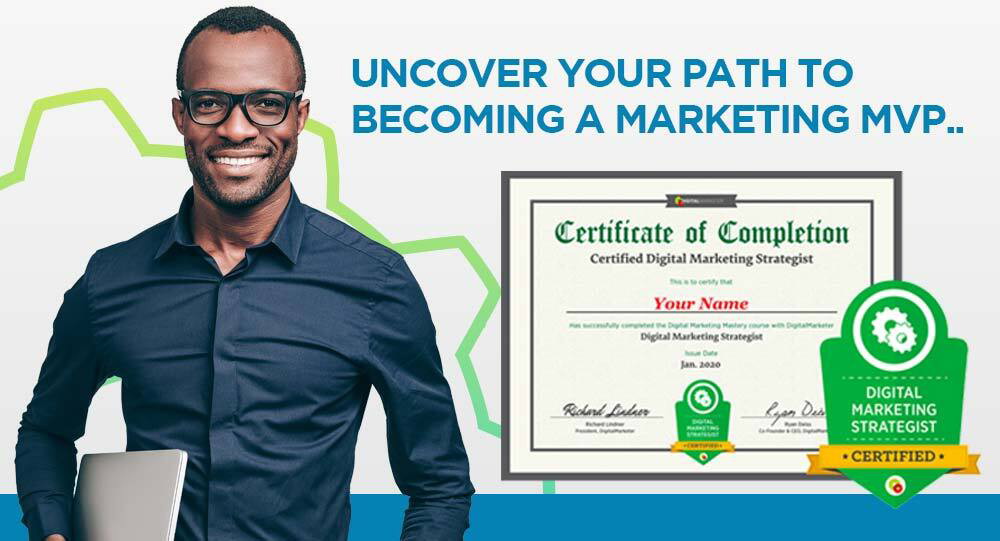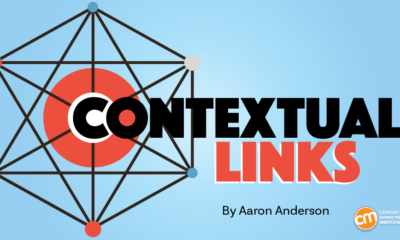MARKETING
Mastering AI-Powered Sales and Marketing: 10 Steps to Success in 2024
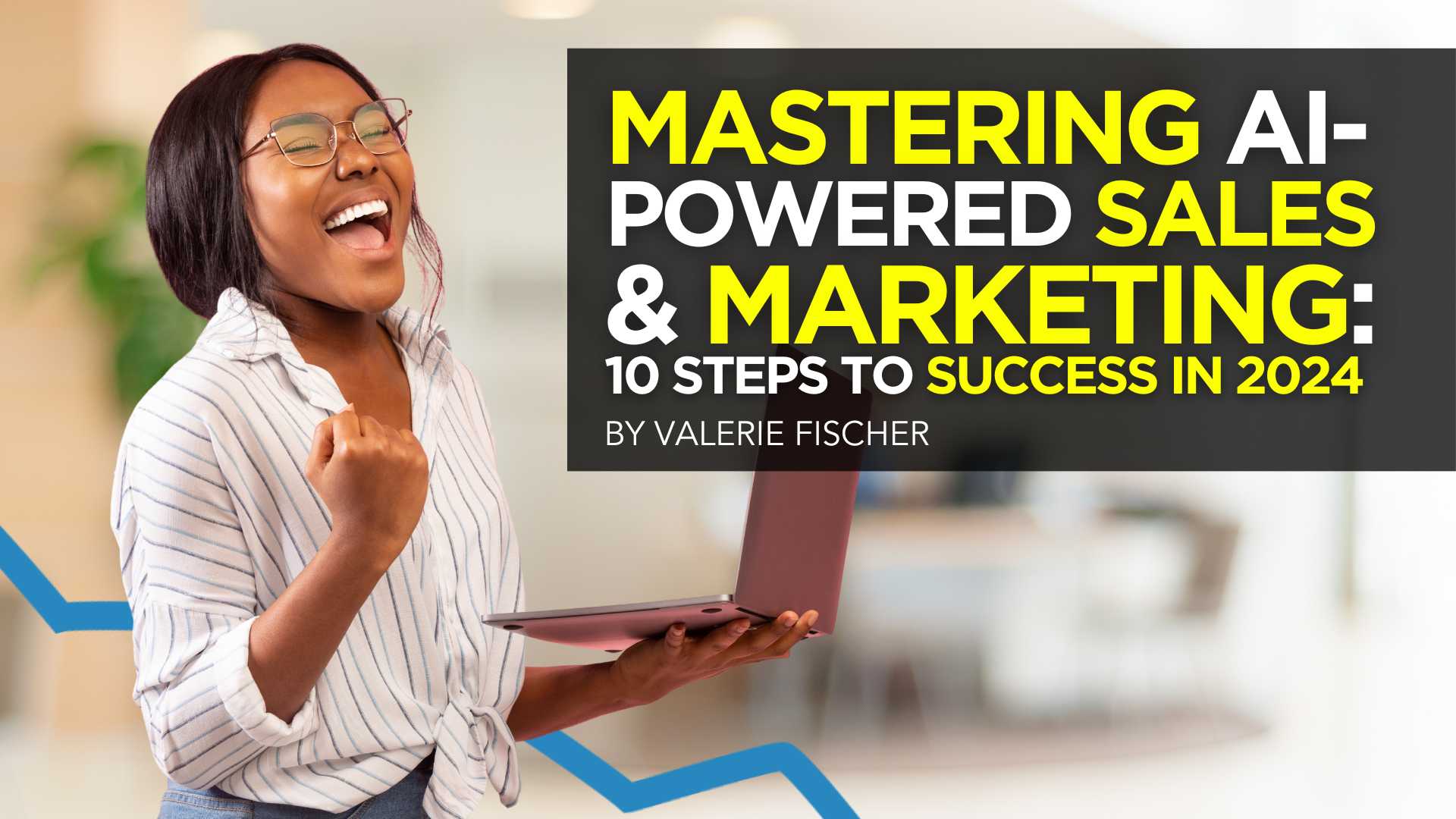
As we gear up for 2024, the marketing and sales landscape is evolving at breakneck speed, with Artificial Intelligence (AI) at its core. To ensure you not only keep up but thrive, let’s dive deep into the actionable steps you need to take. We’ll also explore real-world case studies of how other digital marketers are leveraging these concepts for unparalleled success.
1. Solutions, Not Products: Crafting Compelling Messaging
To excel in 2024, it’s crucial to shift your focus from merely promoting products to highlighting the solutions they offer. Your customers don’t want products; they seek solutions to their problems and needs. Here’s how to do it:
Actionable Step: Go on ChatGPT and use a prompt asking it for relevant insights on your target market. Revisit your marketing collateral, website, and social media content. Ensure your messaging centers on how your offerings directly address pain points and deliver tangible solutions.
Real-World Case Study: Airbnb’s “Live Anywhere” campaign is an excellent example of this principle in action. Instead of showcasing properties, they emphasized the experience of living anywhere, tapping into the desire for flexible lifestyles, especially post-pandemic.
2. Master Prospecting: Elevating Lead Conversion
With a multitude of online leads at your disposal, the next critical step is turning them into enthusiastic prospects. Employ these strategies:
Actionable Step: Implement Conversational Commerce techniques, such as psychology and Neuro-Linguistic Programming (NLP), in your direct messages and online interactions to create rapport and spark interest.

Real-World Case Study: HubSpot, a leading CRM platform, used personalized video messages in their email outreach to engage leads. This personal touch significantly increased response rates and conversions.
3. Know Your Audience: Personalization Through Research
Thoroughly researching your clients before meetings or presentations is paramount. Discover common interests and preferences to initiate meaningful conversations:
Actionable Step: Study how Rapport, a Neuro-Linguistic Programming concept that states “people like people who are like them”. Knowing how your clients are like and what they like will get them to like you. Also leverage social media platforms like LinkedIn, Facebook, and Instagram to gather insights about your clients. Use this knowledge to craft personalized pitches and foster connections.
Real-World Case Study: Coca-Cola’s “Share a Coke” campaign personalized their products by printing customers’ names on bottles. This simple but effective personalization strategy led to a significant boost in sales and customer engagement.
4. Deep Customer Understanding: The WIIFM Approach
Understanding your audience’s needs is the cornerstone of effective marketing. Your product or service must provide a clear answer to the question, “What’s In It For Me?” (WIIFM):
Actionable Step: Conduct in-depth customer surveys, interviews, AI-powered quizzes, and feedback analysis to identify pain points and preferences. Tailor your offerings to directly address these needs.
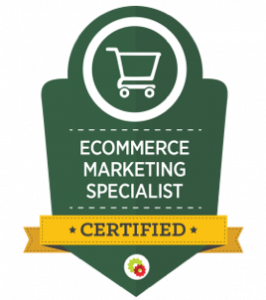
Become A Certified E-Commerce Marketing Master
The Industry’s Most Comprehensive E-Commerce Marketing Certification For The Modern Marketer. Turn Products Into Profit, Browsers Into Buyers, & Past Purchasers Into Life-Long Customers.
Real-World Case Study: Amazon’s product recommendations based on previous purchases and browsing history are a prime example of WIIFM in action. This personalization strategy drives a significant portion of their sales.
5. Storytelling Mastery: Engaging Through Narratives
Storytelling is a potent tool to connect with your audience emotionally. It engages the brain’s mirror neurons that puts the listeners and viewers in the shoes of the storyteller.
Actionable Step: Go on visual AI tools like Midjourney or Canva and develop a prompt that will show your ideal client in the story that you are telling ie “Digital nomad working by the beach” or “student-athelete winning his first championship” to have complementary visuals to your story. Develop a library of customer success stories and case studies. Craft narratives that resonate with your audience’s experiences and demonstrate how your offering solves their problems.
Real-World Case Study: Nike’s “Find Your Greatness” campaign told inspirational stories of everyday athletes, showcasing their struggles and triumphs. This emotionally charged storytelling resonated with a global audience and significantly boosted brand loyalty.
6. Embrace Video Marketing: Captivate Your Audience
Video is the dominant medium across platforms like TikTok, Instagram Reels, webinars, and live streams. It’s essential to engage your audience effectively through video:
Actionable Step: Invest in video content creation and distribution. Create short, attention-grabbing videos for platforms like TikTok and Instagram Reels. Host webinars and live events to foster deeper connections. Then use AI tools like Vizard or Descript to cut, edit and repurpose your content to appeal to different settings and emotions. You can make it casual, formal, or even funny with just one long-form content.

Real-World Case Study: Dollar Shave Club’s humorous and relatable video marketing campaigns went viral, showcasing the power of video content. Their witty approach led to explosive growth and brand recognition.
7. Understand the Sales Funnel: Guiding Your Customers
Grasping the stages of the sales funnel, from awareness to action, is fundamental. Optimize your digital performance by:
Actionable Step: Implement a well-structured sales funnel. Utilize platforms like The Conversion Engine to streamline and enhance the customer journey.
Real-World Case Study: Salesforce’s sales funnel is a prime example of an effective customer journey. Their CRM platform guides leads from awareness to action, resulting in increased conversions and customer retention.
8. Active Listening: Engaging Your Audience
Listening to your audience actively and empathetically is key to understanding their needs and sentiments:
Actionable Step: Conduct polls, surveys, and interactive social media campaigns to gather customer feedback and preferences. Use this data to tailor your messaging and offerings. You can then feed this data to train an AI assistant that can be housed inside your website. AI Business Solutions is doing this for small businesses, and I also have this on my own website. It will feel like you ar reading your customer’s minds and will in turn build rapport and trust with them.
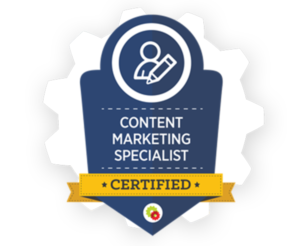
Want to get certified in Content Marketing?
Leverage the tools and channels to predictably and profitably drive awareness, leads, sales, and referrals—EVERYTHING you need to know to become a true master of digital marketing. Click Here
Real-World Case Study: Starbucks’ “My Starbucks Idea” platform encourages customers to submit suggestions and feedback. This active listening strategy has led to product innovations and enhanced customer loyalty.
9. Meet Buyers Where They Are: Tailored Communication
Tailor your communication to match different stages of the customer journey and adapt it to relevant platforms:
Actionable Step: Segment your audience based on their journey stage and preferences. Craft tailored messages and content for each segment and platform accordingly.
Real-World Case Study: Spotify’s personalized playlists, such as “Discover Weekly,” curate music based on users’ listening habits. This tailored approach keeps users engaged and returning to the platform.
10. The AI-Powered Revolution: Leveraging AI
In 2024, AI will play a central role in marketing and sales. Embrace these AI-powered strategies:
Actionable Step: Invest in AI-powered predictive analytics, content creation, social media marketing, sales forecasting, and automation tools. Use AI to target high-value leads and enhance customer engagement.
Real-World Case Study: Netflix’s recommendation engine, driven by AI, suggests personalized content to users. This has led to increased user satisfaction and longer subscription retention.

While AI is set to revolutionize marketing and sales in 2024, remember that it’s a tool. Effective communication, clarity, and an in-depth understanding of your market remain paramount. By implementing these actionable steps and drawing inspiration from real-world case studies, you’ll not only adapt to the evolving landscape but also thrive in the AI-powered future of sales and marketing. It’s time to turn knowledge into action and drive unparalleled success in 2024 and beyond.
MARKETING
3 Contextual Link-Building Strategies That Actually Work
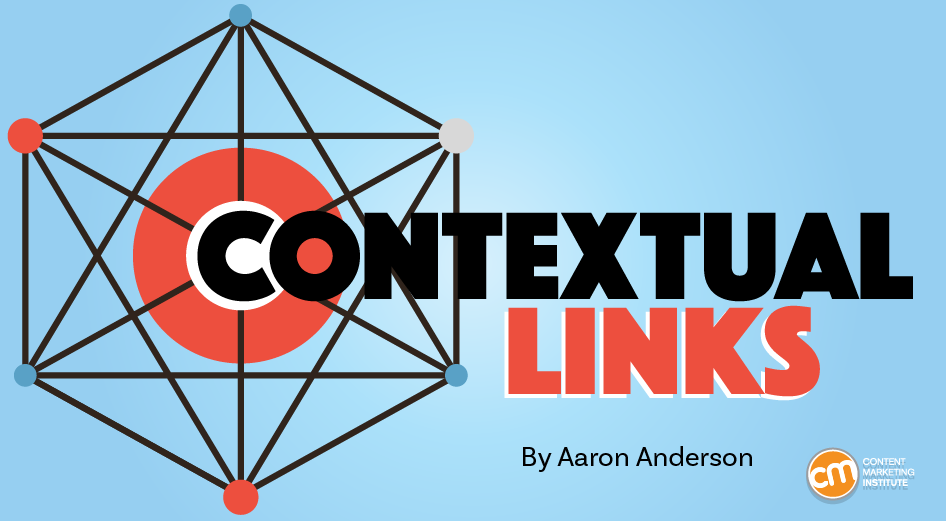
Quality content can get your web pages ranking higher in Google search results. But contextual links can help, too.
Google says the inclusion of relevant, high-quality links signals the content that includes them may be quality content, too.
So, how can you earn contextual links to give your content an edge over the competition? Adopt one, two, or all three of the strategies detailed in this article.
But first, let’s understand what contextual links are.
What are contextual links?
A contextual link appears in the body of a web page’s content. A hyperlink is added to a relevant word or phrase. They:
- Link to other pages on the site.
- Cite the source of a claim or statistic.
- Indicate other relevant pages.
- Provide readers with more in-depth information on the topic.
- Guide readers to a product or service.
In this screenshot of an article with the header, Challenges of Productivity Tracking in Remote Workplaces, three phrases are hyperlinked — measure productivity, Microsoft, and research by Gartner.
Each contextual link serves a purpose:
- “Measure productivity” goes to a Slack article about how to measure employee productivity.
- “Microsoft” directs the reader to the original research for the cited statistic.
- “Research by Gartner” links to the native source for the research cited in that paragraph.
With a contextual link-building strategy, you not only boost your content in the eyes of Google but also encourage other sites to use your valuable content to provide their readers with additional information or context.
Now, let me show you three strategies to grow your contextual links and improve your content’s rankings.
1. Help sites fix their broken links
Broken link building involves contacting a website, pointing out a broken external link on a page, and suggesting your content as its replacement.
Broken links could result from a 404 error, a blank page, or a redirect to an irrelevant page — any alteration that ruins the original link’s purpose.
Since broken links negatively affect the visitor experience, removing them is in the site’s best interest. Your replacement offer gives them a quick solution to their problem. Plus, people are more willing to help you after you’ve helped them.
To find broken links, use a tool like Free Backlink Checker extension. I also like to inspect links manually since most tools only pick up 404 errors. Rely solely on them, and you will miss relevant broken-link opportunities.
Ahrefs also has tools for finding broken links. Its free broken link checker is helpful, but the paid version is more robust.
Paid subscribers can go to Site Explorer, go to the Outgoing Links report, and click on “Broken Links” from the dropdown menu.
The report identifies the total number of broken links (3,136 in the example below), the referring pages (the URL for the content including the broken link), the anchor (the words hyperlinked in the content), and the link (the URL that no longer directs to a viable page).
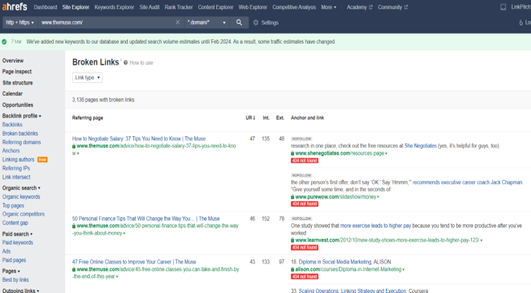
Ahrefs subscribers can also compile a Best by Links report under the Pages option in the Site Explorer tool.
In this example, the report lists pages with 404 page-not-found errors for TheMuse.com. It has 6,230 pages with broken external links. Each page URL listed is accompanied by the number of referring domains and a number of links to the page.
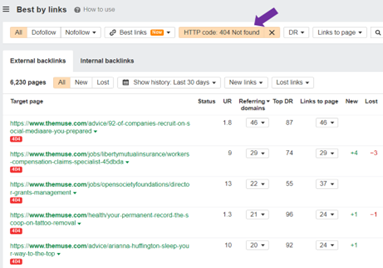
This research can identify the topics with the biggest potential to become the fixes for a broken link. You can create content to address them or identify content you already published. Just make sure the content closely matches the intent of the anchor text’s original link.
For example, the same research report, which is now a broken link, is cited in articles from Oyster and TINYpulse. On Oyster, the anchor text reads, “44% of companies did not allow remote work.” On TINYpulse, the anchor text says, “only 33% are very satisfied with the level of trust in their organization.”
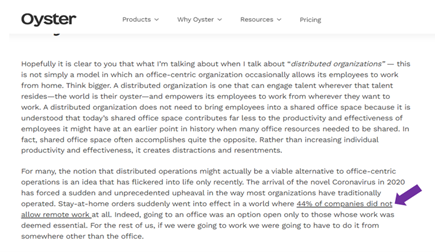
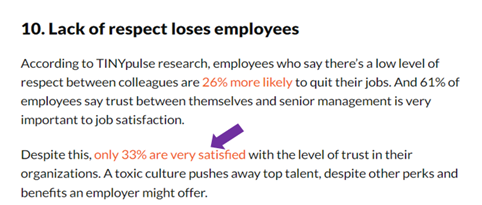
For a single article link to replace the broken link on Oyster and TINYpulse, the content would need to cite both a statistic about remote work and another stat about trust in organizations.
2. Guest posting
Like the broken-link replacement strategy, guest posting benefits both your and the recipient’s sites. You reach out to sites and offer to write content about a topic relevant to their audience that relates to your content subjects and includes a link to your site. This technique works well because you typically control where and how to add your link to make it as relevant as possible.
You can take multiple approaches to win guest-posting opportunities. No matter which tactics you use, track the sites and verify the site’s quality using Ahrefs, another tool, or a direct visit to the site.
First, you can use Ahrefs (or a similar tool) to examine your competitors’ backlinks and identify any links that come from guest posts. The anchor or surrounding text might hint at its status with phrases such as “contributed by,” “guest post by,” or the name of the brand or author. You also can check links manually to see if they’re contributed content.
In this example from Collegiate Parent, the headline reads “EFC Too High? Tips for Successful Aid Appeals” and includes a byline for “Billie Jo Weis.” At this point, you don’t know if it is a contributed article.

But scroll down to the end, and you can see the author’s bio. It confirms the article is a guest post because her bio says she is a client services advisor for My College Planning Team, not the publisher (Collegiate Parent).
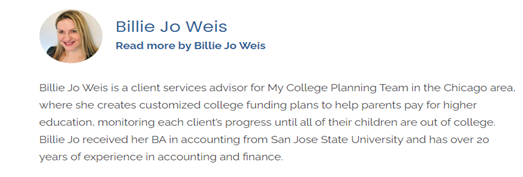
You can also use Google search operators to identify sites open to guest contributions. You’ll want to do several searches using variations of your target keywords and topic accompanied by phrases, such as “guest post,” “contributed by,” “guest post by,” and “guest posting guidelines.”
The example in the screenshot below works for a brand targeting college prep topics. The search is “’college prep’ ‘guest post by’ -site.pinterest.com.” The results reveal four articles from four sites that use the words “college prep” and “guest post by.” You can add those sites to your outreach tracker.

Finally, you can list sites relevant to your niche that didn’t appear in the earlier searches.
TIP: Not all sites that accept guest articles say so on their website.
3. Niche edits
A niche edit, sometimes referred to as a link insert, is a technique that adds a link to existing content. The key to success is finding relevant articles on high-quality sites and pitching your content as a valuable addition to those articles.
You can use a similar process to the Google guest post search. Input a broad keyword for your targeted keyword, then tell it you don’t want the targeted keyword in the title. If the entire article is about your targeted keyword, your chances of getting the publisher to include a link to a similar article are low.
Here’s an example from one of our client’s that sought to make niche edits for the keyword “soft skills.”
The Google search included these phrases:
- “Organizational development” soft skills -intitle:”soft skills”
- “Organizational development” soft skills employee training -intitle:”soft skills”
- Soft skills employee training -intitle:”soft skills” organizations
It led to an added link for “soft skills” in this article — “Employee Development,” which includes the header, “What are the benefits of employee development for an organization?”
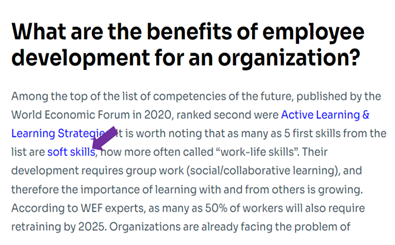
You can do several searches, modifying your search operators each time to see what sites and content appears. Think of multiple angles to broaden the potential sites that publish content with your targeted or a related keyword.
After you’ve crafted a list of high-quality prospects, it’s time for outreach.
Niche edits might be the hardest of the three strategies to achieve because they’re not as clear of a win-win situation as the other two (repairing broken links and publishing new content).
Your email pitch can make or break your niche-edit campaign. It must convince the publisher that your content provides so much value that they will want to take an extra step with content they’ve already completed.
Here are some tips to craft a link-earning email pitch:
- Start by mentioning something about them. It could be something you like about their website or the article you’re targeting. You want them to know you’ve explored their site and read the article. But don’t overdo it. A simple compliment or sentence about how you found the article helpful should suffice.
- Introduce your content and mention how it can help their audience. Be concise and convincing, but don’t oversell it.
- Go one step further and point to a section or sentence where you think your content might be a good fit. This will help them see where your content can add value and link to it.
Get linking
Though contextual link building may seem challenging to execute, it can bring great rewards. Follow these tips and strategies, and your valuable content will get more attention from external sites and eventually Google rankings where it deserves to be.
All tools mentioned in this article are identified by the author. If you have a tool to suggest, please tag CMI on social.
HANDPICKED RELATED CONTENT:
Cover image by Joseph Kalinowski/Content Marketing Institute
MARKETING
Google’s Surgical Strike on Reputation Abuse
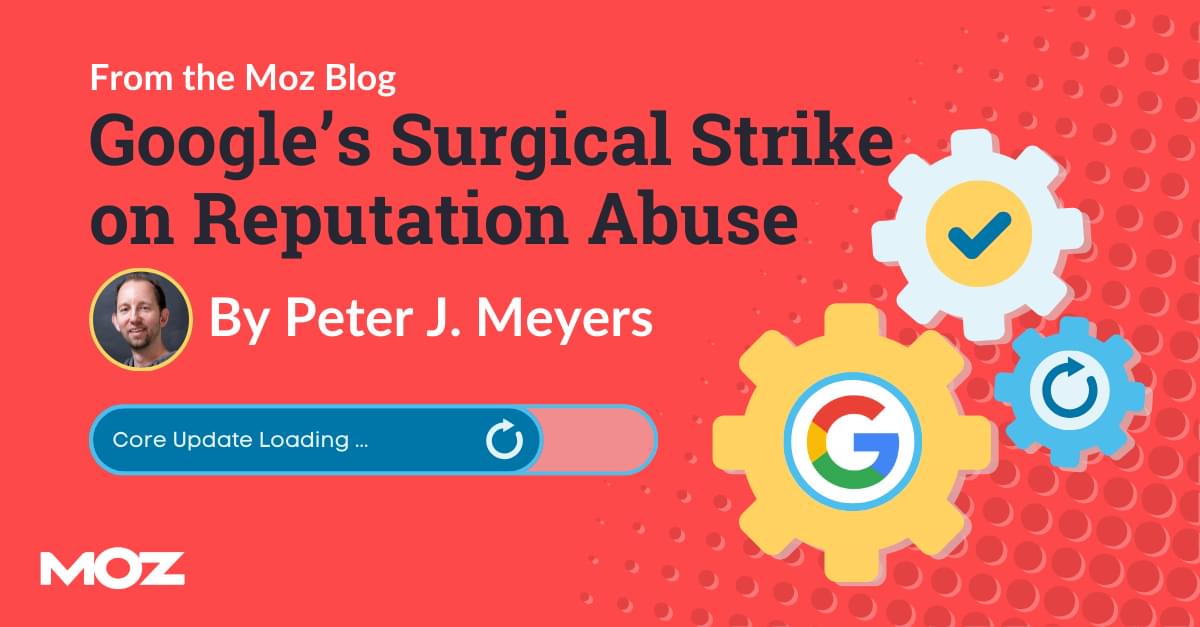
These aren’t easy questions. On the one hand, many of these sites do clearly fit Google’s warning and were using their authority and reputation to rank content that is low-relevance to the main site and its visitors. With any punitive action, though, the problem is that the sites ranking below the penalized sites may not be of any higher quality. Is USA Today’s coupon section less useful than the dedicated coupon sites that will take its place from the perspective of searchers? Probably not, especially since the data comes from similar sources.
There is a legitimate question of trust here — searchers are more likely to trust this content if it’s attached to a major brand. If a site is hosting third-party content, such as a coupon marketplace, then they’re essentially lending their brand and credibility to content that they haven’t vetted. This could be seen as an abuse of trust.
In Google’s eyes, I suspect the problem is that this tactic has just spread too far, and they couldn’t continue to ignore it. Unfortunately for the sites that were hit, the penalties were severe and wiped out impacted content. Regardless of how we feel about the outcome, this was not an empty threat, and SEOs need to take Google’s new guidelines seriously.
MARKETING
18 Events and Conferences for Black Entrepreneurs in 2024
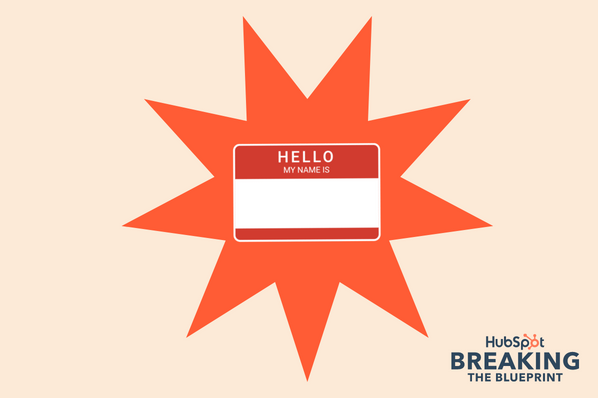
Welcome to Breaking the Blueprint — a blog series that dives into the unique business challenges and opportunities of underrepresented business owners and entrepreneurs. Learn how they’ve grown or scaled their businesses, explored entrepreneurial ventures within their companies, or created side hustles, and how their stories can inspire and inform your own success.
It can feel isolating if you’re the only one in the room who looks like you.
-

 SEO7 days ago
SEO7 days agoHow to Use Keywords for SEO: The Complete Beginner’s Guide
-

 MARKETING2 days ago
MARKETING2 days ago18 Events and Conferences for Black Entrepreneurs in 2024
-

 MARKETING5 days ago
MARKETING5 days agoAdvertising on Hulu: Ad Formats, Examples & Tips
-
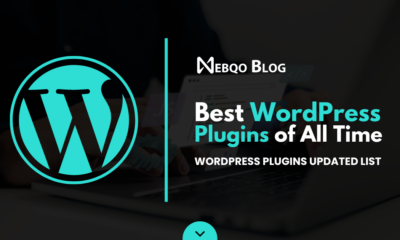
 WORDPRESS5 days ago
WORDPRESS5 days agoBest WordPress Plugins of All Time: Updated List for 2024
-

 MARKETING6 days ago
MARKETING6 days agoUpdates to data build service for better developer experiences
-

 WORDPRESS6 days ago
WORDPRESS6 days agoShopify Could Be Undervalued Based On A Long-Term Horizon
-

 PPC6 days ago
PPC6 days agoLow Risk, High Reward YouTube Ads alexking
-
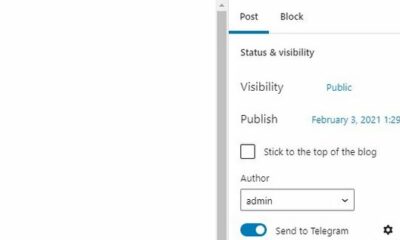
 WORDPRESS4 days ago
WORDPRESS4 days ago5 Must See Telegram Plugins for WooCommerce


